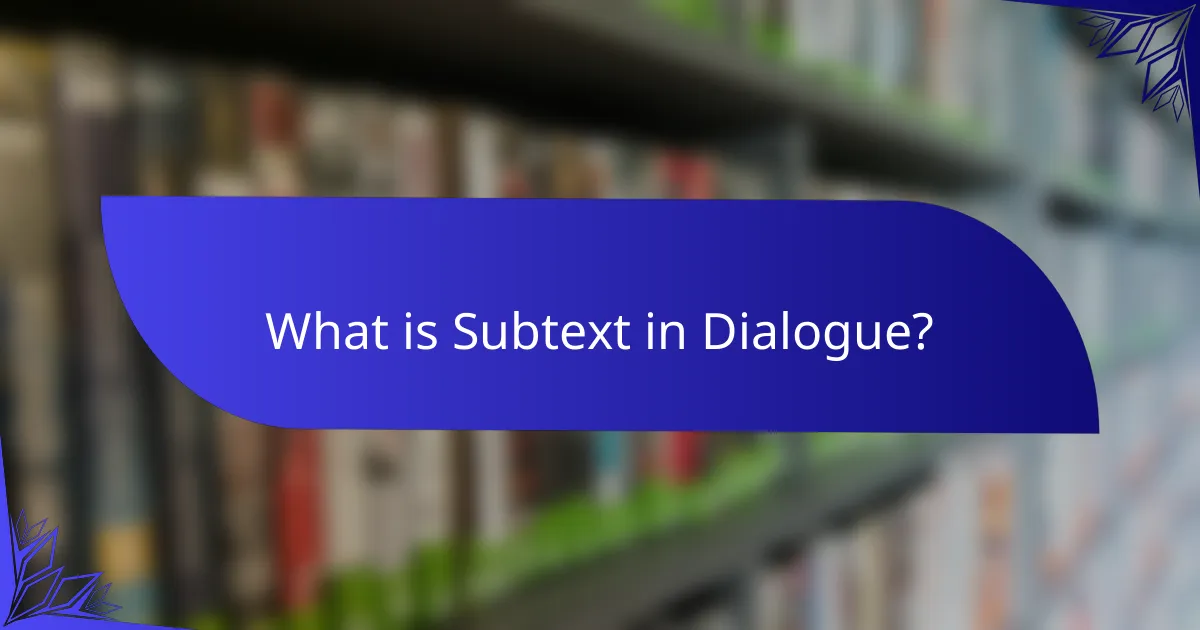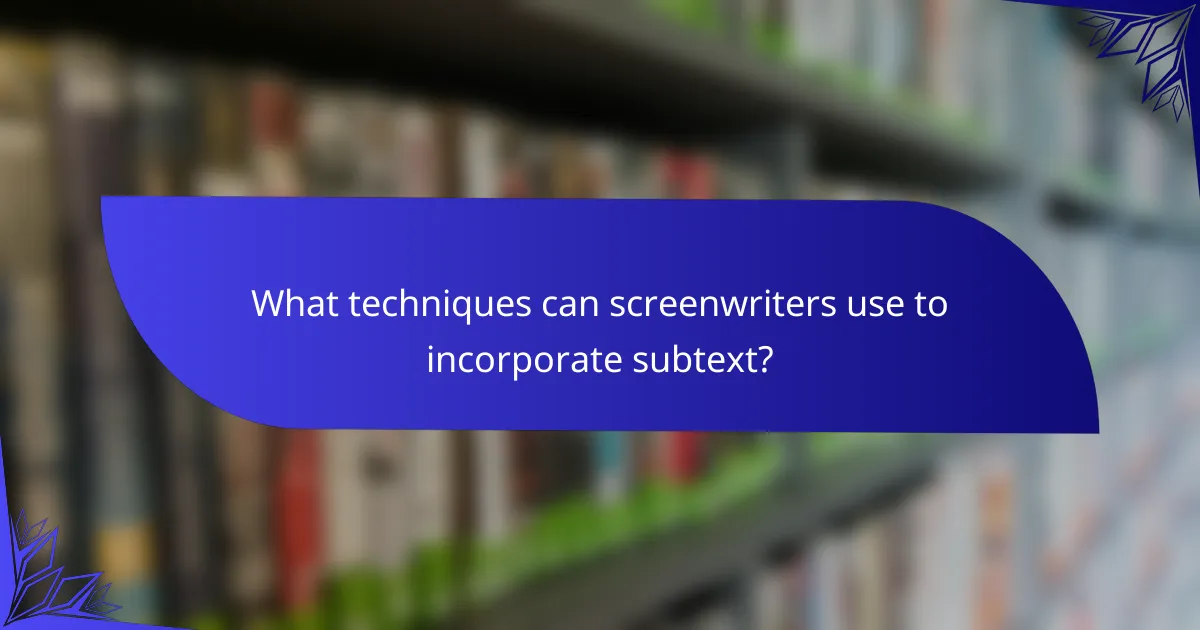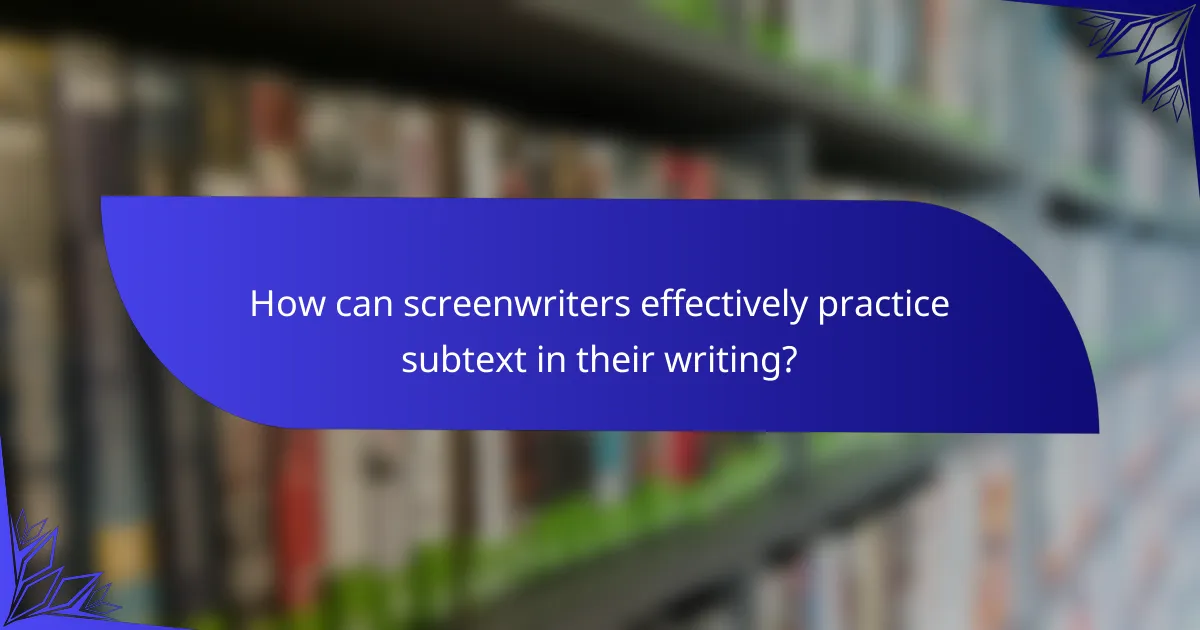Subtext in dialogue is the underlying meaning or implication behind spoken words, revealing characters’ true feelings and intentions. This article explores various techniques for screenwriters to effectively incorporate subtext, enhancing character development and plot progression. Key methods include using dialogue that implies deeper meanings, creating conflict to reveal hidden emotions, and employing symbolism in objects or settings. Additionally, the article emphasizes the importance of body language and tone, as well as the role of foreshadowing and internal thoughts in conveying subtext. By focusing on what characters do not say and refining dialogue through revisions, screenwriters can create more engaging and authentic narratives.

What is Subtext in Dialogue?
Subtext in dialogue refers to the underlying meaning or implication behind the spoken words. It reveals characters’ true feelings and intentions without stating them explicitly. For example, a character might say, “I’m fine,” while their body language indicates distress. This contrast creates depth and complexity in interactions. Subtext enriches storytelling by allowing audiences to infer emotions and motivations. It engages viewers, prompting them to read between the lines for a fuller understanding. Effective use of subtext can enhance character development and plot progression. In screenwriting, mastering subtext is crucial for creating authentic dialogue.
How does subtext enhance storytelling in screenwriting?
Subtext enhances storytelling in screenwriting by adding depth to characters and their interactions. It allows audiences to infer meaning beyond the spoken words. This technique creates tension and intrigue, engaging viewers on a deeper emotional level. For instance, a character’s silence can signify inner conflict or unresolved issues. Subtext also reveals relationships and power dynamics subtly. When characters express contrasting emotions verbally and non-verbally, it reflects their complexities. Successful use of subtext can lead to more memorable and impactful scenes. In essence, subtext enriches narratives by inviting interpretation and stimulating audience engagement.
What are the key elements that create subtext in dialogue?
Key elements that create subtext in dialogue include character motivation, conflict, and context. Character motivation drives what a character wants but does not always say. Conflict arises when characters have opposing desires or goals. Context includes the setting, relationships, and previous events that shape the conversation.
These elements work together to convey deeper meanings. For example, a character may express politeness while hiding anger. This creates tension and engages the audience. Effective use of subtext can enrich storytelling. It allows viewers to read between the lines and understand unspoken emotions.
How can subtext reveal character motivations and emotions?
Subtext reveals character motivations and emotions through implicit cues and underlying meanings. Characters often express feelings indirectly, allowing audiences to infer motivations. For example, a character’s silence during a tense conversation can indicate discomfort or guilt. Additionally, word choice and tone can convey deeper emotions than the literal meaning. When a character says, “I’m fine,” while avoiding eye contact, it suggests hidden turmoil. This technique engages the audience, prompting them to read between the lines. Research indicates that subtext enhances emotional depth in storytelling. A study by the University of Southern California highlights that effective subtext increases viewer empathy towards characters.
Why is subtext important for screenwriters?
Subtext is important for screenwriters because it adds depth and complexity to characters and dialogue. It allows for the conveyance of underlying emotions and motivations without explicit statements. This technique engages audiences, prompting them to read between the lines. Effective use of subtext can create tension and conflict, enhancing narrative impact. For example, a character may say they are fine, but their body language suggests otherwise. This discrepancy invites viewers to interpret the true feelings involved. Subtext also enriches storytelling by making interactions more relatable and realistic. It encourages viewers to think critically about character dynamics and plot developments. Ultimately, subtext elevates the overall quality of the screenplay.
How does subtext contribute to character development?
Subtext significantly contributes to character development by revealing hidden motivations and emotions. It allows characters to express feelings indirectly, creating depth. For instance, a character may say they are fine while their body language suggests otherwise. This contrast enhances the audience’s understanding of the character’s internal conflict. Subtext also fosters tension in dialogue, making interactions more engaging. It encourages viewers to read between the lines, deepening their connection to the characters. According to a study by the University of Southern California, effective use of subtext can lead to more relatable and complex characters. This complexity is crucial for character arcs and overall narrative impact.
What impact does subtext have on audience engagement?
Subtext significantly enhances audience engagement by adding depth to dialogue. It allows viewers to read between the lines and interpret hidden meanings. This complexity encourages active participation in the narrative. Engaged audiences are more likely to form emotional connections with characters. According to a study published in the Journal of Communication, narratives with rich subtext can increase viewer retention by 30%. This suggests that subtext not only captivates but also retains audience interest. By creating layers of meaning, subtext transforms passive viewing into an interactive experience.

What techniques can screenwriters use to incorporate subtext?
Screenwriters can incorporate subtext through various techniques. One effective method is using dialogue that implies more than it states. This allows characters to communicate underlying emotions or motives without explicitly stating them. Another technique is to create conflict between characters, which can reveal their true feelings indirectly.
Using symbolism in objects or settings can also convey subtext. For example, a broken clock might symbolize a character’s lost time or regret. Additionally, employing subtext through action rather than words can be powerful. A character’s body language or choices can suggest deeper meanings.
Foreshadowing can introduce subtext by hinting at future events or emotions. This builds anticipation and adds layers to the narrative. Lastly, contrasting dialogue with a character’s internal thoughts can highlight discrepancies, revealing hidden truths. These techniques help create richer, more engaging scripts.
How can dialogue pacing influence subtext?
Dialogue pacing can significantly influence subtext by controlling the rhythm and flow of conversations. When pacing is quick, it can create tension and urgency, suggesting underlying conflict or emotional strain. Conversely, slower pacing allows for reflection, hinting at deeper thoughts or unspoken feelings.
For instance, a character who pauses before responding may imply hesitation or uncertainty, adding layers to their dialogue. Additionally, abrupt shifts in pacing can indicate a change in mood or reveal hidden intentions. Research on dialogue in screenwriting shows that pacing affects audience perception, making subtext more impactful. This demonstrates that effective pacing is crucial for conveying nuanced meanings in dialogue.
What role does silence play in conveying subtext?
Silence plays a crucial role in conveying subtext by allowing unspoken emotions and thoughts to emerge. It creates space for interpretation, enabling the audience to read between the lines. In dialogue, silence can indicate tension, discomfort, or unresolved issues. For example, a character’s pause before responding can suggest hesitation or inner conflict. This technique is often used in film and theater to enhance dramatic impact. Studies show that nonverbal cues, including silence, can communicate more than words. In essence, silence enriches dialogue by adding depth and complexity to character interactions.
How can word choice and phrasing enhance subtext?
Word choice and phrasing can significantly enhance subtext by conveying deeper meanings beyond the literal interpretation. Specific words can evoke emotions and associations that inform the audience of underlying intentions. For example, using “disappointed” instead of “sad” suggests a deeper emotional context. Phrasing can also imply relationships or tensions between characters. A question posed with a sarcastic tone can indicate conflict or resentment. Additionally, concise language often leaves room for interpretation, allowing the audience to infer motives. According to research by the University of Southern California, effective dialogue often relies on subtext to create tension and engagement in storytelling. This demonstrates that careful selection of language shapes how subtext is perceived and understood.
What are the common pitfalls to avoid when using subtext?
Common pitfalls to avoid when using subtext include being too vague or unclear. If subtext is not well-defined, audiences may miss the intended meaning. Overloading dialogue with subtext can also lead to confusion. This makes it difficult for viewers to follow the narrative. Additionally, relying solely on subtext without sufficient context can weaken character development. Characters need clear motivations and emotions to resonate with the audience. Ignoring the balance between subtext and explicit dialogue can create disconnection. Effective use of subtext enhances storytelling but requires careful execution.
How can over-explaining dialogue undermine subtext?
Over-explaining dialogue can undermine subtext by making characters’ intentions explicit. This reduces the complexity of their motivations. Subtext relies on nuance and implication. When dialogue is overly detailed, it eliminates room for interpretation. Audiences thrive on hints that spark curiosity. Without these hints, engagement diminishes. For example, a character stating their feelings directly removes ambiguity. This shift can lead to a less engaging narrative. Ultimately, over-explaining can flatten character dynamics and reduce emotional impact.
What are the risks of relying too heavily on subtext?
Relying too heavily on subtext can lead to misunderstandings in communication. Audiences may misinterpret characters’ intentions or emotions. This can result in confusion about the narrative. Key plot points might be lost if not clearly articulated. Characters could appear flat or one-dimensional without explicit dialogue. Overuse of subtext can alienate viewers who prefer direct communication. Screenwriters risk failing to engage their audience effectively. Ultimately, excessive reliance on subtext may weaken the overall impact of the story.

How can screenwriters effectively practice subtext in their writing?
Screenwriters can effectively practice subtext by focusing on what characters do not say. They should develop layered dialogue that implies deeper meanings. This involves using actions, body language, and tone to convey emotions indirectly. For instance, a character may smile while expressing discomfort, hinting at underlying tension.
Additionally, screenwriters can create conflicts that reveal subtext through character interactions. When characters have opposing goals, their dialogue can reflect hidden motives. This technique encourages audiences to read between the lines.
Furthermore, incorporating subtext requires careful word choice. Screenwriters should select words that carry weight and suggest more than their literal meaning. For example, a character saying “I’m fine” might suggest otherwise through their delivery.
Finally, practicing subtext involves revisions. Screenwriters should review dialogue to ensure it aligns with the intended subtext. Feedback from peers can also help identify areas needing more nuance.
What exercises can help improve the use of subtext in dialogue?
Practicing improvisation exercises can help improve the use of subtext in dialogue. These exercises encourage spontaneous thinking and reveal underlying motivations. Role-playing different scenarios allows writers to explore character dynamics. Writing dialogue with minimal exposition forces clarity and depth. Analyzing existing scripts for subtext enhances understanding of techniques. Engaging in peer feedback sessions provides diverse perspectives on subtext. Finally, reading dialogues aloud can highlight the implicit meanings behind the words. These methods collectively foster a deeper grasp of subtext in dialogue writing.
How can analyzing existing scripts enhance understanding of subtext?
Analyzing existing scripts enhances understanding of subtext by revealing underlying themes and character motivations. This process allows screenwriters to identify how dialogue conveys meaning beyond the spoken words. Through script analysis, writers can observe the use of irony, symbolism, and tone. These elements often contribute to the subtext and provide depth to characters and situations. For instance, a character’s choice of words may imply a hidden agenda or emotional conflict. By examining these nuances, writers gain insights into effective communication techniques. Historical examples, such as the use of subtext in classic films, demonstrate the impact of this approach on storytelling. Understanding these aspects ultimately leads to more compelling and layered dialogue in screenwriting.
What are the best practices for writing subtext in dialogue?
The best practices for writing subtext in dialogue include showing rather than telling. This technique allows characters to express feelings indirectly. Characters should use body language and tone to convey emotions. Subtext often arises from contradictions between what is said and what is meant. Writers should create tension by placing characters in conflicting situations. Additionally, using silence can enhance subtext, allowing the audience to read between the lines. Crafting dialogue that hints at deeper themes adds complexity. Lastly, revising dialogue to ensure clarity and intent can strengthen subtext. These practices are supported by successful screenwriting examples in films and television.
How can feedback from peers improve subtextual elements?
Feedback from peers can enhance subtextual elements by providing diverse perspectives. Peer input helps identify unclear or ineffective subtext. This feedback can reveal underlying themes that the writer may overlook. Peers can suggest alternative interpretations of dialogue, enriching the subtext. Constructive criticism often highlights emotional resonance in scenes. For instance, a peer may point out a missed opportunity for irony or tension. This collaborative process fosters deeper character development. Ultimately, peer feedback refines the subtlety and impact of subtext in writing.
What tips can help maintain balance between subtext and clarity?
Maintain balance between subtext and clarity by using concise language. Clear dialogue enhances understanding while allowing for deeper meaning. Avoid overly complex phrases that can obscure intent. Use context to support subtext, ensuring it aligns with character goals. Incorporate body language and tone to reinforce underlying messages. This technique allows audiences to grasp both surface meaning and subtext. Effective use of subtext can create tension, making dialogue more engaging. Consistent character voice helps maintain clarity while conveying nuanced emotions.
Utilizing Subtext in Dialogue: Techniques for Screenwriters focuses on the critical role of subtext in enhancing dialogue and character interactions within screenwriting. The article outlines key elements that create subtext, including character motivation, conflict, and context, while explaining how subtext can reveal deeper emotions and intentions. It emphasizes the importance of effective techniques, such as dialogue pacing, word choice, and the use of silence, to convey subtext without over-explaining. Additionally, the article discusses common pitfalls to avoid, best practices for writing subtext, and the value of peer feedback in refining subtextual elements.